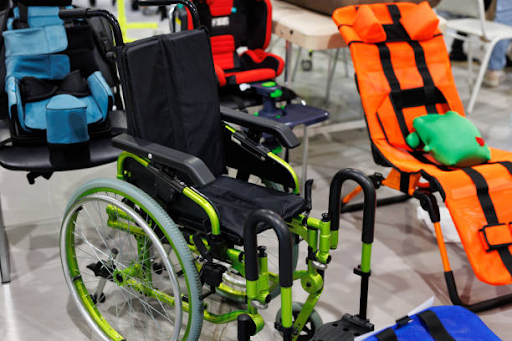Children wheelchairs and pediatric wheelchairs are constructed in such a way as to accommodate the special mobility requirements of young passengers who need such aids because of physical disabilities or medical history. These wheelchairs are comfortable, safe, and functional to enable children to move freely, engage in activities and become more independent. The choice of the appropriate pediatric wheelchair entails the knowing of the physical needs of the child, growth prospects, and general lifestyle.
Why Pediatric Wheelchairs and Wheelchairs for Children Are Different
Tailored for Growth and Comfort
In contrast to the normal wheelchairs, children wheelchairs and pediatric wheelchairs have modular components. Such features like the width of the seat, its height and the backrest support are adjustable as the child develops. This flexibility guarantees the longevity of use and comfort with the limited requirements of frequent replacement.
Safety and Stability
When designing pediatric wheelchairs and wheelchairs that are used by children, safety is a concern. They are fitted with superior braking mechanisms, anti-tip bars and strong frames to avoid accidents. Also padded chairs and harnesses can be used to ensure correct posture and avoid pressure sores.
Portable and Simple to handle.
Mobility aids among children need to be light and easy to manage. Pediatric wheelchairs are crafted using such materials as aluminum or titanium and are therefore durable, but light. The design can additionally enable children, caregivers or parents to move the wheelchair in and out of the house with ease.
Types of Pediatric Wheelchairs and Wheelchairs for Children
Pediatric Manual Wheelchairs.
Manual pediatric wheelchairs are those that are used with children with sufficient upper-body strength to push themselves. They encourage exercise and self-sufficiency. The models are also usually small and can be folded and this makes them ideal in traveling or at school.
Power Pediatric Wheelchairs.
Power pediatric wheelchairs and wheelchairs for children are a good solution for children who have limited arm power or severe mobility problems. They have battery-driven motors that can be operated by a touch interface or joystick. Such models provide easy mobility and increase independence.
Recline and Tilt Pediatric Wheelchairs.
Tilt and recline wheelchairs are the ones that are aimed at children who require pressure relief or those who struggle to sit up. These models have the benefit of adjusting the seat angle so that one is comfortable sitting in a position over long periods and eliminates some strain on the spine.
Active Pediatric Wheelchairs and Sports.
Active or sports pediatric wheelchairs are designed to accommodate children who are sport oriented i.e. basketball, tennis or racing. They are constructed to be light framed, have quick-release wheels and ergonomic seating to ensure agility and performance.
Key Features to Look for in Pediatric Wheelchairs and Wheelchairs for Children
Adjustabilit
The child who is growing requires a wheelchair which is able to be changed with time. Find ones with adjustable seat depths, height and back support. This provides correct posture and a long lifespan.
Portabilit
Parents have to carry wheelchairs quite frequently. A foldable and lightweight model is chosen to make the process of traveling and storing easy without compromising on the durability.
Customization Options
The children are special in their preferences and needs. Such custom features as color choice, type of wheel and other possibilities (trays or cup holders) are offered in most pediatric wheelchairs. The individualization will make the children feel more secure and comfortable with their mobility assistance.
Benefits of Pediatric Wheelchairs and Wheelchairs for Children
Promotes Independence
Wheelchairs used by the pediatrics allow the child to move comfortably and this makes them full of confidence and self esteem. They can be used in school, at home or even in a place of worship as more people can be integrated in the daily activities
Improves Emotional and Physical wellbeing.
The mobility has a direct impact on social interaction and mental health of the child. With the help of the well-designed children wheelchairs for children wheelchairs, their users can enjoy better interaction with their surroundings and other children.
Supports Rehabilitation
These wheelchairs are necessary to children who are recovering injuries, or receiving therapy. The design is ergonomic and assists in up-keeping the right posture and healthy physical development
Enhances the quality of life of families.
Pediatric wheelchairs are highly convenient and trustworthy to the parents and the people taking care of the children. They decrease the physical weight of having to deliver the child or support him everywhere and this makes the day to day tasks easier.
How to Choose the Right Pediatric Wheelchairs and Wheelchairs for Children
Consider the Environment
Consider the areas of maximum usage of the wheelchair. Wheels and thick frames are essential when used outdoors. Compact and easily manoeuvreable models are the best where the use is indoors.
Focus on Safety Features
Make sure that the pediatric wheelchair has proper brakes, seat belts and frames that are stable. Safety: It should be the first factor to consider in choosing wheelchairs among children.
Conclusion
Children wheelchairs and pediatric wheelchairs are not merely mobility assistive, but freedom, inclusion and empowerment devices. The correct model to be chosen is related to the comfort, safety, and flexibility to the special needs of the child. Using the appropriate wheelchair, children will become more independent, healthy, and active.







